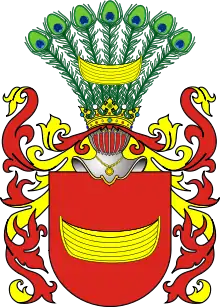Jan IV of Kępa
Jan of the Lodz coat of arms (died on 14 April 1346) was bishop of Poznań and author of sequences and antiphon.[1]
Biography
He was born as the son of the wielding Sędziwoja knight.
On the pages of history, he appears for the first time in 1319, when as the chancellor of the Poznań bishop he joined the delegation appointed by the papal judges, who was to hand the lawsuit against the Teutonic Knights on the trial between Poland and the Order on Gdańsk Pomerania. It is known that during this process he participated in the meetings of the court in Inowrocław and Brześć Kujawski. He was also included in the judgment of 1321 ending this trial as one of the witnesses. In the same period he received the post of Archdeacon of Poznań. In 1331 he was almost killed during the Teutonic military expedition to Greater Poland, when the Order's troops captured the Słupca.
In 1335 he received the dignity of the bishop of Poznań. As a new bishop, together with Janisław I, Archbishop of Gniezno, he challenged the Order to the Roman Curia. During the trial in 1339, which took place in Warsaw between the Order and Poland, the defendant as a witness issued both a negative opinion on the rule of Władysław Łokietek in Pomerania and on the crimes committed by the Teutonic Order. He gave up his claims, like the rest of the bishops, in 1343 at the conclusion of the Kalisz peace. In 1344, he started the reconstruction of the Poznań cathedral in the Gothic style. He died on 14 April 1346 and was buried in the cathedral.
Creativity
Several hymns have been written to our times in honor of the Mother of God and saints. Presumably, he also composed an inscription beginning with the words of Hic iacet in Tumb, engraved on the grave of Bolesław the Brave founded by one of his predecessors on the episcopal throne, Bogufała II. According to the accounts, Bishop Jan was also a musician playing the zither.
Musical Works
- Salve salutis janua (sequence for the celebration of the Assumption of the Virgin Mary in 16 verses),[2][3]
- In laudem sacro praesuli (sequence in honor of St. Adalbert, with acrostic: Johannes presul Posnaniensis);[4][5]
- Lux clarescit in via (Marian antiphon)[6]
- De sancto Paulo (sequence: inc: Paule, doctor egregie ...)[7]
Name
Sometimes it is called Jan of Kępa after Jan Długosz, although it is probably a chronicler's mistake, because in the 14th century Kępa belonged to the Dolivs.
References
- Bibliografia Literatury Polskiej – Nowy Korbut, vol.2 Piśmiennictwo Staropolskie, Państwowy Instytut Wydawniczy, (Warszawa 1964), p.495-496
- published by G. M. Dreves Analecta hymnica medii aevi, vol. 10: "Sequentiae ineditae", Leipzig 1891, p. 54.
- (according to the 15th century). - J. Surzyński, the Mother of God in Polish music, Kraków 1905, music addition, pp. 6-7 (here, Fri. Prosa de Assumptione Mariae, with notes); ed. critics H. Kowalewicz "Cantica Medii Aevi Polono-Latina", vol. 1: "Sequentiae", Warsaw 1964, Bibl. Latina Medii et Recentioris Aevi, vol. 14; sources mention H. Kowa
- ed. critics H. Kowalewicz "Cantica Medii Aevi Polono-Latina", vol. 1: "Sequentiae", Warsaw 1964, Bibl. Latina Medii et Recentioris Aevi, vol. 14;
- message about the sequence: In laudem sancti sacro presuli ..., as probably identical to the work of J. Łódź, gave M. Liebeskind "Sequencer Tarnowski" (XVI century); Music 1930, No. 6
- ed. critics H. Kowalewicz "Cantica Medii Aevi Polono-Latina", vol. 1: "Sequentiae", Warsaw 1964, Bibl. Latina Medii et Recentioris Aevi, vol. 14.
- ed. C. Blume Analecta hymnica ..., vol. 42, Leipzig 1903, pp. 281-282; ed. critics H. Kowalewicz "Cantica Medii Aevi Polono-Latina", vol. 1: "Sequentiae", Warsaw 1964, Bibl. Latina Medii et Recentioris Aevi, vol. 14 (authorship likely in the opinion of H. Kowalewicz) Tu es Petrus et super hanc petram ..., sequence in honor of Saint. Piotr (authorship assumed by M. Liebeskind, mistakenly identified by H. Kowalewicz)
